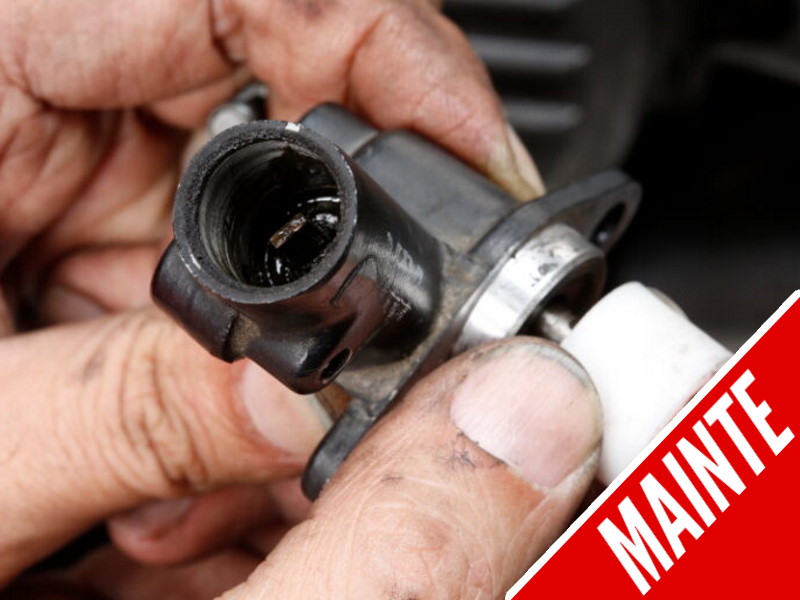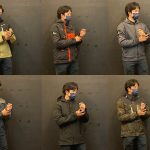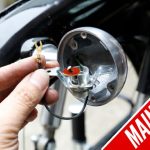Most modern models use an electric speedometer, which replaces the number of revolutions of the wheel with an electrical signal to drive the speedometer. A typical mechanical speedometer is a speedometer that is driven by a gear built into the wheel hub. Starting in the late 80's, Honda's racer replica models began using a drive system that rotates the meter cable by installing a "joint or coupling" over the center nut that tightens the drive sprocket.
In this article, I will focus on the "extraction" of the speedometer gear for such type of models. Let's practice disassembly maintenance.
Gears on the extension of the coaxial core of the drive sprocket


In modern terms, this is summed up in the super sports model, but in the 80's, there were racer replicas, and then models called "real racer replicas" after the movement heated up. At that time, there were many models that eliminated the meter cable drive with one purpose of simplicity around the front wheel, the meter cable was along the fixed side = body side and the speedometer gear was taken out from the drive sprocket rotation axis. This was the case with the VFR/RC/NC/NSR series, for example.
Plastic coupling to drive the cable


The speedometer gear is built into the drive sprocket cover, and is set into the head of the center bolt that secures the drive sprocket via a plastic part that is the "coupling" that connects the two inside the cover. This mechanism allows the meter gear to rotate with the head of the bolt synchronized with the rotation of the drive sprocket.
New parts are fixed with low-pressure fit

It depends on the condition of the vehicle, but the coupling of the meter gear for RVF400R which was disassembled this time, was easy to pull out by fingertip because of the rattle, although it should be low press fit. It was easy to pull it out by fingertip. Some of the motorcycles that had been ridden had this coupling rattled more and destroyed it. After cleaning the gears, the new parts (which were still supplied at the time of this photo) were press-fitted. At this time, a vise was used to press-fit and fix the parts so that they would not be pressed in too far.
I applied some buffer grease to the contact area.

Grease is applied to the contact area between metal parts and resin parts for the purpose of functioning as a buffer. Since it is a resin x metal part, rubber grease was used so as not to affect the resin part. We want to avoid contamination with chain grease, but since the drive sprocket is in the center of the sprocket, it seems unlikely that the centrifugal force will cause chain grease to scatter and stick to the sprocket. It's important to clean the parts when the sprocket cover is removed.
Check the operation of the metering gear.

After fixing the coupling parts, let's rotate them with your fingertips and check if the shaft that drives the meter cable is rotating. The internal gears are not sold separately, so if they are very dirty, clean the parts and use a grease sprayer with an ultra-fine nozzle to seal the grease without damaging the seals.
Model RVF representing the best era of motorcycles

The unprecedented boom in motorcycles that began in the early 1980s spawned numerous new models. In the latter half of the 80s, when the popularity of racing was particularly high, models that looked like production racers with only security parts installed appeared on the market. Even in the mid-sized motorcycle class, Honda offered a lineup of models that boasted intense performance: the two-stroke NSR series evolved year by year, while the four-stroke CBR series was enhanced with a parallel four-cylinder engine, and the VFR/The RVF series was also a model that fostered many sport riders. The Honda RVF400R was the last racer replica of the V-cylinder 400cc model that was introduced in the early 90s, and its distinctive Honda V4 exhaust sound is a distinctive feature of this model.
- Point 1: Clean the surrounding parts when disassembling parts, e.g., when removing various covers.
- Point 2: To be able to cope with sudden maintenance, we should have three types of grease: MP (multi-purpose) grease, rubber grease and molybdenum disulfide grease.
Most of the motorcycle instruments = meters are driven by wire cable type. Today, many electric meters are driven by electric signals, but it was in the early 80's that electric meters began to be adopted. At that time, the adoption of the electric speedometer as well as the electric tachometer was regarded as an advanced technology, but there were still many troubles due to the transitional period of the technology. However, the technology was still in its infancy, and there were still many problems. Most of the models that used electric speedometers did not continue to be adopted and were short-lived.
The engineers wanted to do something about the presence of the meter gear, which was a hindrance to steering operation and also provided resistance to rotation. Even before the 1970s, some foreign-made British motorcycles had a speedometer driven from the rear wheel hub, and it is said that this was also a result of the pursuit of light steering operation.
Honda's racer replica models hid the speedometer gear and cable from the front wheel, and with the 1983 amendment to the Vehicle Code allowing models with a full cowl, the speedometer cable could easily interfere with the under-cowl when driven by the front wheel. When the speedometer cable is driven by the front wheel, it tends to interfere with the under cowl. This led to the development of a system with the speedometer drive gear on the drive sprocket.
Many modern sportbikes use electrical signals from the rotation of the rear wheel to drive the speedometer. In this way, a variety of technological advances are hidden in parts of the motorcycle that we normally don't pay attention to. For more than a hundred years since the introduction of the motorcycle, the style of riding has remained unchanged, with the rider straddling the motorcycle between the two front and rear tires and operating the handlebars. However, a variety of technological advances have made it possible for modern motorcycles to provide a stable and secure ride.
What we have focused on here is the area around the speedometer drive gear that has been used in Honda's sports motorcycles since the late 80's. When the sprocket cover is removed, not only should the sprocket, drive chain, and inside of the case be cleaned and inspected, but the area around the meter gear should also be checked and inspected, and parts should be replaced if necessary. In particular, check the condition of the coupling part (known as the speedometer joint) that transmits the drive rotation power to the meter gear, and keep spare parts on hand before it becomes unusable.




